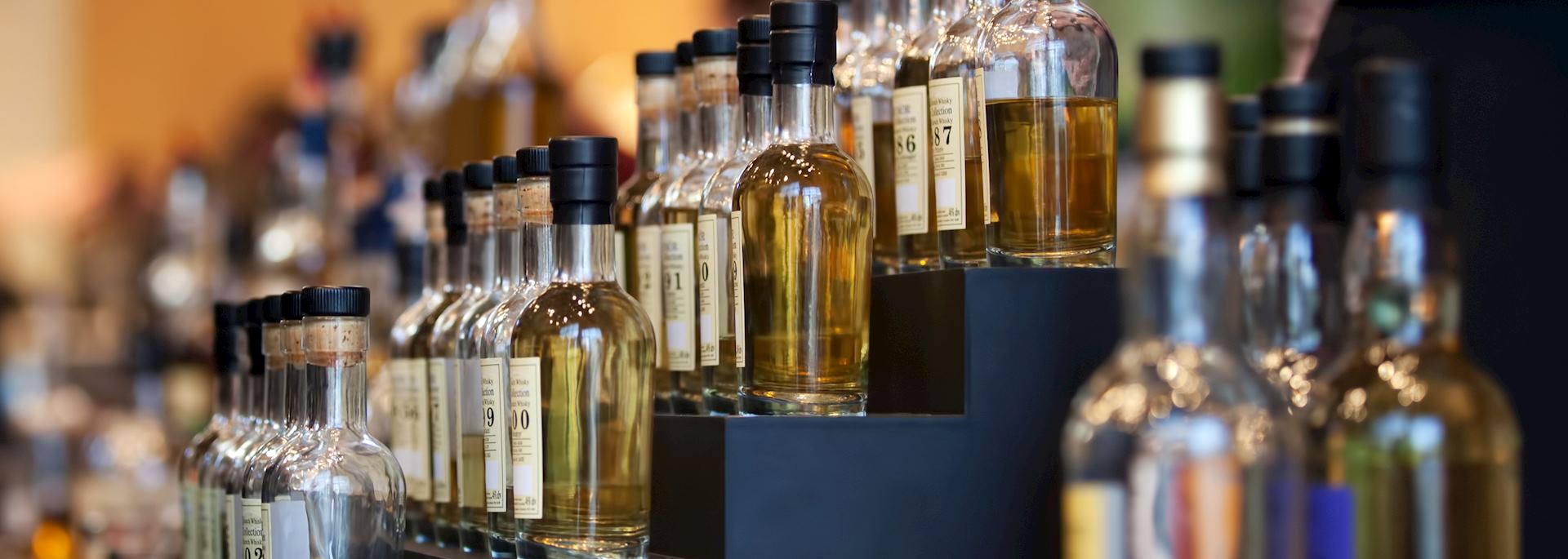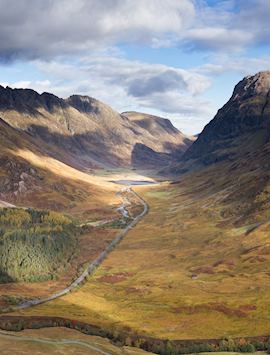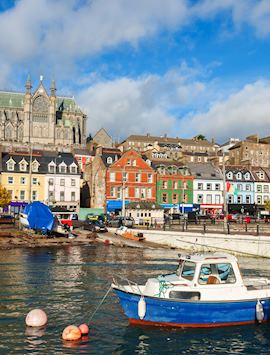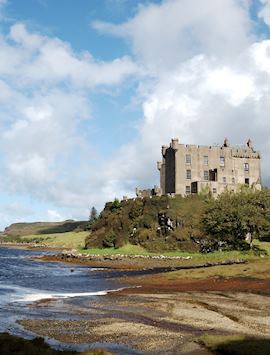By UK & Ireland specialist Andea
I’ve always preferred smoky, peaty whiskies like Laphroaig and Lagavulin — rich single malts that smell like well-worn leather and taste like the smoke from a good cigar. Which isn’t to say that I don’t enjoy the gentle honeysuckle and vanilla notes of a Lowland bottle, too.
Terroir is a word that usually applies to wine rather than spirits, but the best distillery tours can deepen your appreciation of whisky’s ‘taste of place’. Standing on the living peat and visiting the wind-cooled malting floors, it starts to dawn just how entwined the drink is with the land, water and air of where it was born.
Whisky in Scotland
Whisky is a significant industry in Scotland, not just as a drink, but also as a major attraction for visitors. At many distilleries — especially along the Malt Whisky Trail in Speyside — huge buses pull up every hour on the hour and disgorge hordes of enthusiasts, there for a tour, tasting and free souvenir glass.
The big-name houses offer excellent tours conducted by entertaining professionals, and there’s nothing wrong with, say, a visit to Talisker. In fact, I always make a point to swing by there when I’m on the Isle of Skye. But, I also like to cultivate a more intimate relationship with my whisky. Happily, many of Scotland’s distilleries also offer smaller tours, tastings with innovative pairings, and even workshops.
There are, depending on who you ask, five or six major whisky-producing regions in Scotland — the Highlands, the Lowlands, Campbeltown, Speyside, Islay and the Islands. Which one makes the best whisky is a matter of heated debate and personal taste, so I won’t wade in.
Islay distilleries

But for distillery tours, I will say that if you only intend to make one whisky stop, Islay is the place to make it. Windswept and still mostly wild, Islay is the southernmost of the Inner Hebrides and home to eight distilleries, including some of the most storied single malt producers in the world. It has just two roads and 3,000 residents, who are easily outnumbered by the birds who live here.
Many of the distilleries here are set right on the coast, taking advantage of the cooling winds off the Atlantic to slow evaporation. Those low temperatures combine with the peaty local water to give the whiskies their distinctive taste, which admirers describe as smoky with hints of brine, leather and spice. (Detractors mutter about burned motor oil and muddy socks. Islay whisky is not for everyone.)
Islay’s history with whisky dates back 500 years, and not all of it is strictly law abiding. I heard some of the hair-raising stories of smuggling and tax evasion on a tour of the tiny island, which also included visits to the white-sand beaches, two distilleries and a small town museum in Port Charlotte.
For a deeper dive into the process, Islay’s Laphroaig hosts a half-day workshop that takes you from water to whisky. Wearing a pair of rubber wellies, you trek out to the water source and peat beds that together give Laphroaig its distinctive earthy, almost medicinal taste — one of the most peaty in all of Scotland.

Cutting the peat out of the ground is a laborious process. You use a long-handled medieval-seeming tool to carve out a long, narrow rectangle of black earth. It comes away from the bed with a slight tearing sound as the blades slice through the damp, matted tangle of grass roots, mosses and fungus. (Mainland peat is more wood-based, the product of decay from old Caledonian forests. The unique Islay peat is another reason for the island’s distinctive single malts.) After drying out under the sun, the peat logs are used in kilns to dry the barley.
This is one of the few distilleries that still malts its own barley, the damp grain laid out on the open floor and turned by hand using a special shovel called a shiel. This allows it to germinate, turning starches into fermentable sugars.
You can also find a malting floor at nearby Kilchoman, the only independent distillery on the island, based on a farm. Founded by Anthony Willis in 2005, it's the island’s only single malt produced entirely on site: they grow and malt their own barley, and age and bottle it right in situ.
A few hours to the north, Oban Distillery also perches on the coast, but it gives you a more urban experience. Founded in 1794, it’s one of the country’s oldest distilleries, and its black-and-gray stone building is right in the heart of the lively port town that shares its name. Hemmed in by the town, it can’t get any larger, so the distillery only offers limited runs.
A tour here reinforces the importance of the casks in which the whisky is aged. Oban prefers to use well-seasoned oak and, as a result, the spirit takes at least 14 years to mellow in the dry wood.
Highland distilleries

Farther inland, Dalwhinnie Distillery sits in the heart of the Highlands, on the edge of the Cairngorms National Park. It’s the highest, coldest distillery in Scotland, and the lower temperatures help to reduce evaporation during the maturation process.
It’s also the prettiest, I think. Even in the summer, the surrounding mountaintops often glint with a dusting of snow, and the low buildings seem to hunker down against the biting winds, their whitewashed walls and black roofs stark alongside the greens and heathered browns of the rising Highlands.
Dalwhinnie is one of the few places left that still uses a worm tub (coils of copper pipe immersed in cold water) instead of a standard shell-and-tube condenser. The simpler device has less copper, which leaves more sulfur in the final product, giving it a meaty chew.
The tasting here pairs different whiskies with artisanal chocolates, handmade nearby. These are unusual chocolates, spiked with strawberries and star anise or raspberry and black truffle. The rich cocoa fat coats the palate and the whisky slices through, combining to highlight and complement the nuances of each. I’m a long-time whisky drinker, but the tasting here was a revelation.
Oban and Dalwhinnie are just two of the four dozen or so distilleries in the Highlands, the largest and, arguably, most diverse of the whisky regions. Offerings range from rich and textured to sweetly floral.
Lowland distilleries
To the south, the Lowlands whiskies have a more uniform profile — light, slightly sweet blends, with floral and citrusy notes, as well as subtle, grassy single malts. There aren’t many Lowland whisky makers left, but the oldest and best-known is Auchentoshan, located just outside Glasgow. Here, the unpeated finished product is triple distilled in three tapered copper stills, resulting in its signature oily, clinging texture and a honeyed scent.
Whiskey in Ireland

Once, Ireland boasted hundreds of distilleries, many barely more than a still in the back of a barn. However, in the early 20th century, Prohibition in America and economic wobbles at home damaged the industry until only a few lingered.
Jameson Distillery
Of the companies that survived this great contraction, the oldest is Jameson, established in Dublin in 1780. You can still visit the original distillery, but I prefer the facility in Midleton, in County Cork. A massive stone building with bright-red wooden doors and shutters, this is the working heart of Irish whiskey production — the water source flows right through the building and the barley is all grown nearby.
A behind-the-scenes tour here offers an in-depth look at the art and science of crafting Jameson, from the massive stills to the micro-distillery, where you get a short class in theory. For me, the most interesting part was a visit to the cooperage, run by the steady hand of master cooper Ger Buckley, a fifth-generation maker of barrels who learned his craft from his father. The tour also includes the distiller’s cottage and ends in the bar for a guided tasting.
If you’re truly serious about your whiskey, you can opt for a full-day workshop with the Jameson master distillers.
Ballykeefe Distillery

On the other end of the Irish whiskey spectrum are the small-still labels. Prompted by the recent surge in whiskey’s popularity, many locals around the country are reviving the industry with tiny farm distilleries.
Most are so new they don’t even have a finished product for you to sample yet — by law, all whiskey must be aged three years and one day, and the best varieties are even older. While they wait for their drink to age, these small companies support themselves by producing gins and vodkas, as well as poitín, whiskey’s raw spirit.
I first sampled poitín at Ballykeefe, a brand-new farm distillery just outside Kilkenny. Perfectly clear, it burned like fire all the way down my throat as its potent fumes uncoiled in my sinuses, making me blink rapidly. Given my preference for peaty whiskeys, I didn’t expect to enjoy so-called Irish moonshine, but it was frankly amazing (and strong). It gave me a chance to understand the importance of the aging process and how much the wood lignin imparts to the final product.
Ballykeefe is a small, family enterprise, run by Morgan Ging and his children in the barn on his farm. Here, you get to see whiskey production on a much smaller scale than at Jameson. Like many of the other micro-distilleries in Ireland, Ballykeefe doesn’t offer a finished whiskey yet. But, you can try their six-times-filtered vodka and extra-dry gin at the tasting room, set in a converted stable where the bar is made from retired barrels.
Read more about trips to Ireland and Scotland
Start thinking about your experience. These itineraries are simply suggestions for how you could enjoy some of the same experiences as our specialists. They're just for inspiration, because your trip will be created around your particular tastes.
View All Tours in Europe




